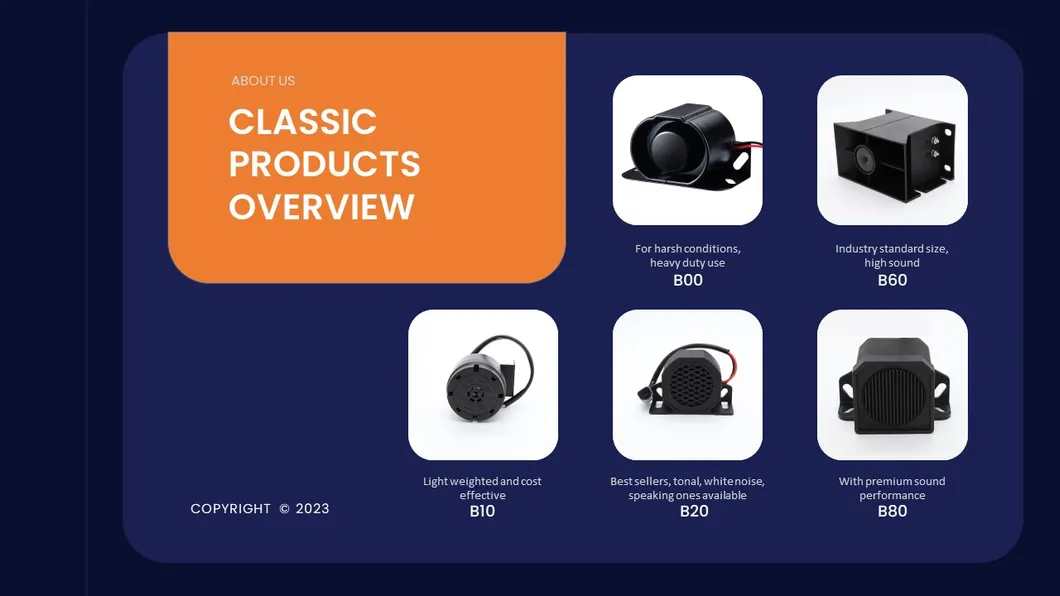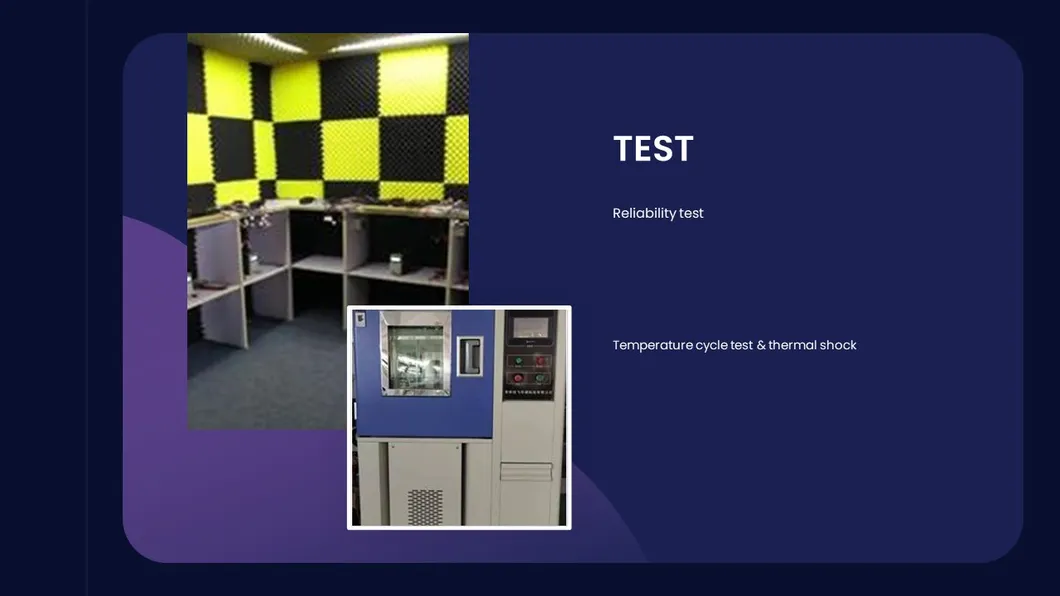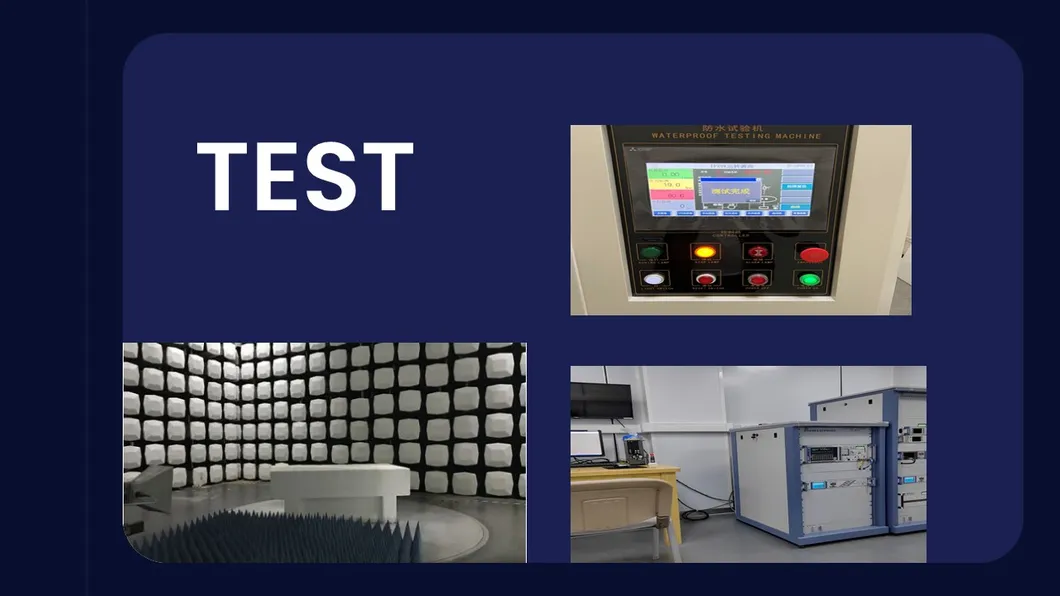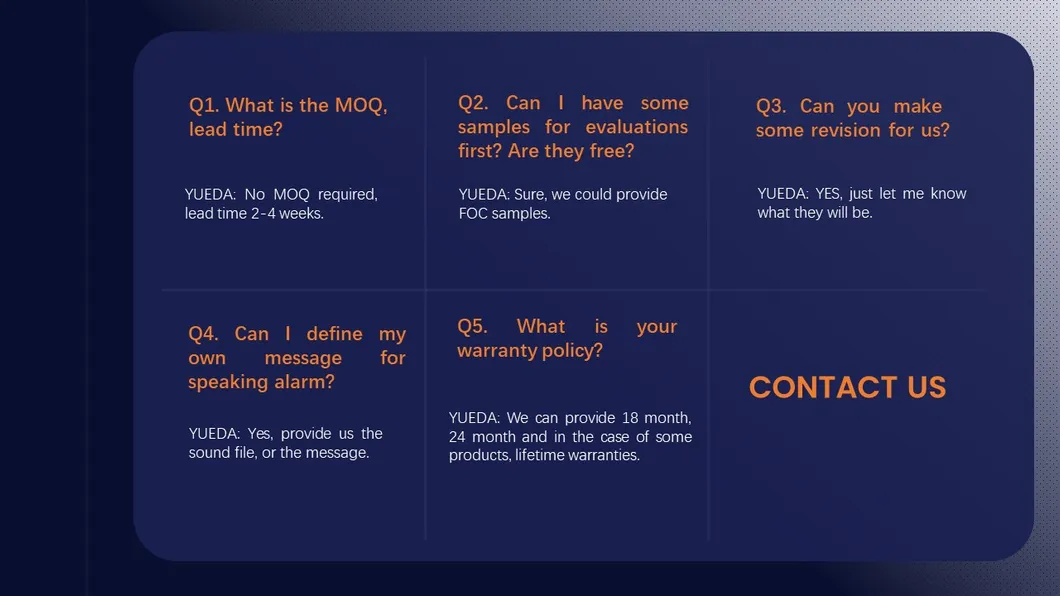





Preview
基本信息产品详情证书
基本信息
| 型号 | YS-B70 |
| 颜色 | 黑色 |
| 关键词 | 防水 |
| 特征 | 稳定 |
| 用于 | 汽车警报 |
| 运输包装 | 每箱40件 |
| 规范 | 环氧树脂 |
| 商标 | 悦索尼克 |
| 起源 | 中国 |
| HS编码 | 8512301100 |
| 产能 | 每月1000000 |
产品详情
Product Description
Preview
Why install reversing alarm and warning alarm?
Reversing alarms and warning alarms, also known as backup alarms or reversing buzzers, are installed in vehicles and equipment to alert pedestrians, workers, and other nearby people to the presence of large moving objects that may be difficult to see. They are commonly used in construction machinery, garbage trucks, delivery vans, and other vehicles and equipment that can pose a danger to pedestrians or workers. When a vehicle is reversing, the reversing alarm usually emits a loud beep, which is a warning sign that alerts people who may be walking or working nearby.
Warning alarm is similar, but may be activated in different situations, such as when a vehicle is turning or changing lanes. The purpose of these warning alarm is to help prevent accidents and injuries, especially in busy and crowded environments where visibility may be limited. Although some areas may have noise restrictions related to reversing and warning alarms, many countries require certain types of vehicles and equipment to have these safety features installed and functioning properly. This helps keep drivers and pedestrians safe and can help prevent accidents and injuries in the workplace and on the road.
Reversing alarms and warning alarms, also known as backup alarms or reversing buzzers, are installed in vehicles and equipment to alert pedestrians, workers, and other nearby people to the presence of large moving objects that may be difficult to see. They are commonly used in construction machinery, garbage trucks, delivery vans, and other vehicles and equipment that can pose a danger to pedestrians or workers. When a vehicle is reversing, the reversing alarm usually emits a loud beep, which is a warning sign that alerts people who may be walking or working nearby.
Warning alarm is similar, but may be activated in different situations, such as when a vehicle is turning or changing lanes. The purpose of these warning alarm is to help prevent accidents and injuries, especially in busy and crowded environments where visibility may be limited. Although some areas may have noise restrictions related to reversing and warning alarms, many countries require certain types of vehicles and equipment to have these safety features installed and functioning properly. This helps keep drivers and pedestrians safe and can help prevent accidents and injuries in the workplace and on the road.
Preview

Preview

Preview

Preview

Preview

Preview

Preview

Preview

Preview
Suitable for:
Light commercial vehicles
Light commercial vehicles
Preview

Preview
1.Specifications
2.Description
3.Applications
Back-up alarm is a device intended to warn passers-by of a
vehicle
moving in reverse. They typically produce 1000
Hz
pure tone
beeps at 97-112
decibels.Matsusaburo Yamaguchi of Yamaguchi Electric Company,
Japan, invented the back-up beeper. It was first manufactured as model BA1 in 1963.ISO 6165 describes "audible travel alarms", and ISO 9533 describes how to measure the performance of the alarms.
Although originally intended as a warning device, sometimes these alarms are used on vehicles in a situation where no one is ever likely to be a passerby. (For example, tractors in fields often use them even though no one is ever walking behind the vehicle). The noise, however, can be heard up to 3 kilometres (1.9 mi) away and disturbs residents and people within the vicinity but who will never be within the danger zone of the vehicle itself. In places, like the City of London, this
noise pollution
has led to a ban on the back-up beeper and alternatives must be used instead.
Back-up beepers are criticized by the public and in scientific literature. Beepers top lists of complaints to government roadbuilders about road construction noise. There is published concern that people become
habituated
to the ubiquitous noise, diminishing its effectiveness. The normal level of 1000
Hz
pure tone
beeps at 97-112
decibels, considerably higher than the long-term
hearing loss
limit of 80 decibelsStrategies such as adjusting the volume according to the ambient noise and changing the tone to include sounds above 1600 Hz and below 800 Hz for improved localization would improve the alarm, but improvements are not cost-effective for the manufacturer and, if implemented by the equipment owner, introduce liability for the owner.
Brains do not adapt to the repetitive and persistent sound of back-up beepers, but have evolved to process natural sounds that dissipate. The sound is perceived as irritating or painful, which breaks concentration.
In some countries, such as the
United Kingdom, back-up warning systems using blasts of
white noise
are becoming more common, and are obligatory for suppliers of some large construction projects. White noise does not have to be as loud as beeps in order to be able to be heard over background noise, and people can more easily hear from which direction the signal comes.
While not addressing the criticism of the type of sound, units exist that moderate the volume based on sensing ambient sound.
4.Competitive Advantage
1).Reinforced nylong housing eliminates corrosion damage
2).Wire/connector/bolt mounting optional, easy to install
3).Voltage polarity protection
4).RoHS compliant, CE certified, IP68 protection
5.Information
6.Custom properties
7.Product commercial terms
2.Description
3.Applications
Back-up alarm is a device intended to warn passers-by of a
vehicle
moving in reverse. They typically produce 1000
Hz
pure tone
beeps at 97-112
decibels.Matsusaburo Yamaguchi of Yamaguchi Electric Company,
Japan, invented the back-up beeper. It was first manufactured as model BA1 in 1963.ISO 6165 describes "audible travel alarms", and ISO 9533 describes how to measure the performance of the alarms.
Although originally intended as a warning device, sometimes these alarms are used on vehicles in a situation where no one is ever likely to be a passerby. (For example, tractors in fields often use them even though no one is ever walking behind the vehicle). The noise, however, can be heard up to 3 kilometres (1.9 mi) away and disturbs residents and people within the vicinity but who will never be within the danger zone of the vehicle itself. In places, like the City of London, this
noise pollution
has led to a ban on the back-up beeper and alternatives must be used instead.
Back-up beepers are criticized by the public and in scientific literature. Beepers top lists of complaints to government roadbuilders about road construction noise. There is published concern that people become
habituated
to the ubiquitous noise, diminishing its effectiveness. The normal level of 1000
Hz
pure tone
beeps at 97-112
decibels, considerably higher than the long-term
hearing loss
limit of 80 decibelsStrategies such as adjusting the volume according to the ambient noise and changing the tone to include sounds above 1600 Hz and below 800 Hz for improved localization would improve the alarm, but improvements are not cost-effective for the manufacturer and, if implemented by the equipment owner, introduce liability for the owner.
Brains do not adapt to the repetitive and persistent sound of back-up beepers, but have evolved to process natural sounds that dissipate. The sound is perceived as irritating or painful, which breaks concentration.
In some countries, such as the
United Kingdom, back-up warning systems using blasts of
white noise
are becoming more common, and are obligatory for suppliers of some large construction projects. White noise does not have to be as loud as beeps in order to be able to be heard over background noise, and people can more easily hear from which direction the signal comes.
While not addressing the criticism of the type of sound, units exist that moderate the volume based on sensing ambient sound.
4.Competitive Advantage
1).Reinforced nylong housing eliminates corrosion damage
2).Wire/connector/bolt mounting optional, easy to install
3).Voltage polarity protection
4).RoHS compliant, CE certified, IP68 protection
5.Information
6.Custom properties
7.Product commercial terms
Preview
证书
标题:GB/T 19001-2016/ISO 9001:2015

Preview
12~24V倒车报警防水Emark车载倒车呼叫器
¥14.41 ~ ¥144.73
运输工具制造产业链 · 汽车安全技术 · 汽车报警器
型号YS-B70
运输包装每箱40件
产地中国


 苏州
苏州  已认证
已认证











